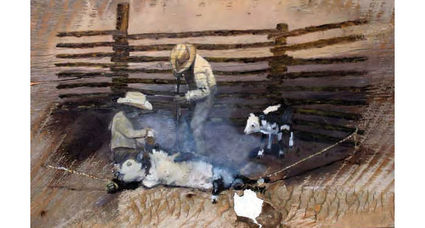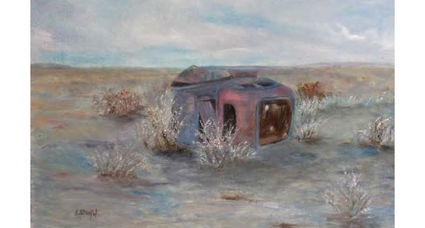HALL RANCH
August 6, 2019

Old Time Branding By Larry & Jane Stanfel During the summer months, the Siemion boys worked as Charlie Hall's ranch hands, their widowed mother, as his cook. In this painting Steve, who passed away here several years ago, pins down the calf as his elder brother brands it. Charlie, himself, was known to be very camera-shy. This painting, executed on old barn wood, was selected as the 2008 icon for the annual Montana Cowboy Poetry Gathering in Lewistown.
To begin, Hall was not the first landowner; it was a Mr. Tupper of Chicago, reportedly a Mafia figure seeking to elude the FBI. If this is true, he was successful, and, along with a ranch, he also managed to find a much younger bride, a local schoolteacher.
Even today, standing on a wind-whipped hill in the midst of a summer day, one feels lonely out there – imagine a winter night! – and it's an unlikely place for a woman alone.
Therefore, in 1938 the widow Tupper sold the ranch, and Charles Henry Hall of Curtis, Nebraska, enters the story. Reportedly his family had been well-to-do, but by the time Charlie sought to fulfil his ranching ambition, he had to provide his own financing. This he accomplished in true western fashion and built his fortune on rodeo prizes.
Thus, it is easy to appreciate his reputation as a tight-fisted loner; for example, his pack of faithful dogs subsisted on potato peels garnished with grease and lard. The ranch never had a decent well, and water was transported from a now-defunct spring a considerable distance across the road. Never squandering the precious fluid on superfluities like washing things, if a dish were not awfully dirty, he turned it over on the table for later use. He wore a pair of jeans until it would not abide another fitting then tossed it into a corner atop a stack of its predecessors. If the uncovered jar lured flies to their deaths, he spread the jelly on a bread slice and then plucked out their corpses.
Depending upon one's informant, his holding expanded over time to between 30 and 60 sections, and even in age the rodeo rider was tough enough to cover the length and breadth of it. Originally raising sheep, he soon amassed a herd of 400-500 cattle also.
Locals believed him wealthy and, unaware that he banked in Billings, that much cash was stashed on the premises. Wisely, then, he slept in his living room with a hip holster full of revolver within easy reach on a wall. There was at least one robbery attempt, which a hired hand helped foil but which earned Charlie a rap on the head.
On the final day of his life Mr. Hall rode out to inspect his property, became ill, but managed to push all the way home to die. Quite soon his brother and heir arrived on the scene, shot all the dogs, and put the ranch on the market. Robert Goffena Sr. purchased it, and the hidden treasure fable persisted, for Mr. Goffena's sons conducted a search for it. Wedged up the chimney was something all right, but it proved to be an old jacket wrapped around a .45 revolver.

Mrs.Tupper's Ford By Larry & Jane Stanfel Directly behind the main ranch buildings is a gully where the Tupper's and Charlie Hall deposited garbage they did not burn. There, surrounded by sage and scraps of wood and metal junk, reposed Mrs. Tupper's car under a beautiful patina of rust.
Now, years before, other rumors whispered that a Texas Ranger had ridden through these parts in search of a fugitive – Mr. Tupper? – and never returned to his base. Imagine their surprise when they found the Texas Rangers' insignia stamped into the gun metal!
People had some interest in other belongings, as well, that Charlie left behind. A neighbor pounced on the stack of unwashed trousers and peddled them on the web as authentic, antique cowboy blue jeans. Charlie's little home was razed to provide lumber for a new house, but perhaps the builder was unaware that the wood had been saturated with insecticides.
Today, rather little of the Hall Ranch buildings survive, but it must not be forgotten this was once Capital of an Empire. A small empire, one might say, but triple the size of Bermuda. An empire hard-won and defended against relentless Nature. It and its ruler, asleep now in Roundup Cemetery, deserve to be memorialized.
What remains of the buildings belonging to the Hall Ranch are located approximately 14 miles on North Gage Road in Musselshell County, Montana.





Reader Comments(0)